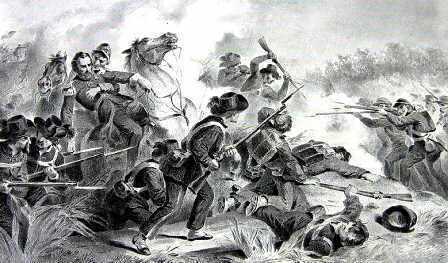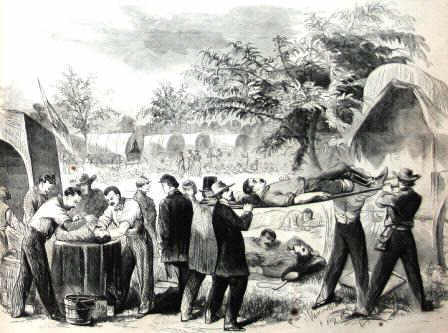| Summary and Definition of Battle of Antietam
Definition and Summary: The Battle of Antietam was fought in Maryland, part of the Eastern theater of war. The infamous Battle of Antietam took place Wednesday, September 17, 1862 and was located at Antietam Creek in Sharpsburg, Washington County. The result of the conflict was inconclusive but the number of casualties was horrendous. The combined forces at Antietam totaled just over 114,000 of which 22,717 men died, were wounded or lost during the military conflict which still remains as the bloodiest single day battle in the history of America. Battle of Antietam
Abraham Lincoln was the 16th American President who served in office from March 4, 1861 to April 15, 1865. One of the key conflicts of the Civil War during his presidency was the Battle of Antietam, the bloodiest single day battle in American history. |
|
| Battle of Antietam
Interesting Facts and information about the Battle of Antietam are provided via the facts sheet provided in this article. Battle of Antietam: What's in a name?
The Battle of Sharpsburg or the Battle of Antietam? Many battles fought during the American Civil War are referred to by different names. The reason for this is that the Confederate Army named battles after nearby towns, farms or even railroad junctions, this example is Sharpsburg. The Union Army often named battles after close natural resources like rivers or creeks, as in Antietam Creek. Battles of Antietam: Strategic Significance
The strategic significance of the Battle of Antietam was, although it resulted in a stalemate, it prevented Robert E. Lee's planned invasion of Maryland and Pennsylvania. | Battle of Antietam 
|
Battle of Antietam Casualties
There were battles fought during the Civil War which had more casualties than Antietam, but these were fought over a longer period of time. The Battle of Antietam casualties all occured on just one single day of fighting. There were 36 casualties a minute for twelve hours. Battle of Antietam Casualties Comparison Chart
The statistics related to the military "casualties" of the Civil War included not only the dead, but also the injured, ill and missing. The figures and statistics chart to your left provide the details of battles with the highest casualties in the American Civil War, as a caparison to the number of casualties at the one day Battle of Antietam. | Civil War Casualties Chart | Battle | Dates | Casualties | | Gettysburg | July 1-3, 1863 | 51,000 | | Chickamauga | September 18-20, 1863 | 34,624 | | Wilderness | May 5-7, 1864 | 29,800 | | Chancellorsville | May 1-4, 1863 | 24,000 | | Shiloh | April 6-7, 1862 | 23,746 | | Antietam | September 17, 1862 | 22,717 |
|
Reasons for the Battle of Antietam Casualties
The reasons for the horrific number of casualties at the Battle of Antietam were due to the dense foggy weather conditions on the day of the conflict, made even worse by the thick smoke of gun fire, the vast number of artillery pieces involved, the desperate but determined actions of the Union and Confederacy. And finally the intense, close-quarter fighting of the troops on both sides that resulted in the high casualties of Americaís bloodiest day. The Battle of Antietam Union casualties, and those of many other battles during the Civil War, would have been even higher had it not been for the efforts of Jonathan Letterman, the "Father of Modern Battlefield Medicine." Battle of Antietam Casualties: Dr. Jonathan Letterman, "Father of Modern Battlefield Medicine"
The systems and techniques required for the battlefield treatment of casualties only began during the Civil War and were pioneered by the army surgeon Dr. Jonathan Letterman (1824-1872). During the American Civil War Dr. Letterman was assigned to the Army of the Potomac. He witnessed the carnage of the early battlefields following which wounded and dying soldiers would be left suffering from excruciating wounds, thirst and exposure. Their only chance of survival was if a comrade carried them off the battlefield field or when one of the few stretcher bearers were able to help the casualties. In 1862 Letterman was appointed medical director of the Union army. It had taken a week to remove the casualties from the battlefield following the Second Battle of Bull Run. Battle of Antietam Casualties: Field Hospital 
| Battle of Antietam Casualties
Dr. Jonathan Letterman then pioneered the very first military Ambulance Corps that would be responsible for saving many soldiers from dying horrible, lingering deaths on the battlefield. Dr. Letterman earned the name "Father of Modern Battlefield Medicine" by instituting a 'triage' system when dealing with casualties. Men were trained in the concept and process of 'triage' which was a system to identify priorities in casualties, designed to maximize the number of survivors. These men worked as stretcher bearers and were provided with wagons to collect the wounded and medical supplies for emergency medical aid. A battlefield evacuation system was established an Antietam, the Ambulance Corps, which consisted of transport to a Field Dressing Station, a Field Hospital and a larger Hospital away from the battlefield for long term care and treatment. Specially designed Hospital Trains were used to carry casualties from field hospitals to the general hospitals - refer to Civil War Inventions and Technology. The battlefield evacuation system, pioneered by Dr. Letterman at Antietam was officially adopted for the U.S. Army by an Act of Congress in March 1864 during the Civil War. |
Battle of Antietam Casualties
The evacuation system was quickly put into place before the Battle of Antietam on September 17, 1862. The newly formed Ambulance Corps succeeded in removing all the casualties from the battlefield in just 24 hours. The newly establish Union Army hospitals treated over 6 million casualties during the war. There were twice as many deaths due to disease than from enemy bullets. Diarrhea and dysentery alone took the lives of 44,558 Union soldiers. |
The Battle of Antietam
The following fact sheet provides interesting facts and information about the Battle of Antietam which was fought shortly after the Second Battle at Bull Run on August 28-30, 1862. Civil War for Kids: Battle of Antietam Fact Sheet | | Facts for Kids | Facts and Information | | First Battle of Antietam Fact 1 | Who were the leaders? The leaders of the Battle of Antietam were General Robert E. Lee for the Confederacy who opposed General George B. McClellan for the Union | | | | First Battle of Antietam Fact 2 | When did it start and where was it fought? The date of the conflict was on Wednesday, September 17, 1862 and fought at Antietam Creek in Sharpsburg, Washington County, in Maryland | | | | First Battle of Antietam Fact 3 | Who won? It was inconclusive battle, but Robert E. Lee's invasion of Maryland and Pennsylvania was stopped, so strategically it was a Union victory | | | | First Battle of Antietam Fact 4 | How many troops were engaged in the Battle? There were 75,000 Union soldiers and 39,000 Confederates | | | | First Battle of Antietam Fact 5 | This famous Civil War conflict at Antietam was infamous as the bloodiest single day battle in American history | | | | First Battle of Antietam Fact 6 | How many casualties were there in the Battle of Antietam? It is estimated that there were 22,717 Union and Confederate casualties | | | | First Battle of Antietam Fact 7 | The areas of conflict during the Battle of Antietam were South Mountain, Millerís Cornfield, Dunker Church, East Woods, West Woods, Bloody Lane (aka Sunken Road) and Burnside Bridge | | | | First Battle of Antietam Fact 8 | The Iron Brigade, an infantry brigade in the Union Army of the Potomac made up almost entirely of German immigrants, fought at Bloody Lane | | | | First Battle of Antietam Fact 9 | Antietam was the first battle in which the Confederate Army took the offensive | | | | First Battle of Antietam Fact 10 | General McClellan was over-cautious and never committed his entire force, whereas General Robert E. Lee engaged his entire army in the battle. General McClellan was later relieved of his command on November 7th, 1862 due to President Lincoln's disappointment in his performance in the battle | | | | First Battle of Antietam Fact 11 | Nurse Clara Barton (1821-19) was present at the battle taking care of wounded soldiers. She would gain fame as the founder of the American Red Cross. | | | | First Battle of Antietam Fact 12 | The future President William McKinley fought as a sergeant for the Union during the conflict at Atietam | | | | First Battle of Antietam Fact 13 | Other Union Leaders in the Antietam conflict included Joseph Hooker, Joseph King Fenno Mansfield, Edwin Vose Sumner, and Ambrose Everett Burnside. | | | | First Battle of Antietam Fact 14 | Other Confederate Leaders in the Antietam conflict included Thomas "Stonewall" Jackson, James Longstreet, Daniel Harvey Hill, Ambrose Powell Hill | | | | First Battle of Antietam Fact 15 | The Battle of Antietam began at 5:30 AM at dawn, and ended the same day at 5:30 P.M | | | | First Battle of Antietam Fact 16 | Following the bloody conflict at Antietam the US government became convinced that black soldiers were desperately needed for the war effort. | | | | First Battle of Antietam Fact 17 | On September 22, 1862, President Abraham Lincoln issued a preliminary Emancipation Proclamation that changed the war aims of the Union. | | | | First Battle of Antietam Fact 18 | By the end of the American Civil War, there were over 180,000 Black Troops fighting for the Union | | | | Facts for Kids | Facts and Information: Battle of Antietam Fact Sheet | Civil War for Kids: Battle of Antietam Fact Sheet |
Battle of Antietam - President Abraham Lincoln Video
The article on the Battle of Antietam provides an overview of one of the major conflicts of the Civil War during his presidential term in office. The following Abraham Lincoln video will give you additional important facts and dates about the political events experienced by the 16th American President whose presidency spanned from March 4, 1861 to April 15, 1865. | | |
| |
|